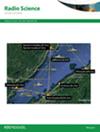Geolocation of the ionospheric irregularities in the equatorial F layer by back propagation of COSMIC-2 radio occultation signals
IF 1.5
4区 地球科学
Q3 ASTRONOMY & ASTROPHYSICS
引用次数: 0
Abstract
Plasma irregularities in the ionosphere induce scintillation of radio signals. Radio occultation (RO) observations of the Global Navigation Satellite Systems (GNSS) signals from low Earth orbit (LEO) allow monitoring of the ionospheric scintillation. Under certain conditions, it is possible to localize (geolocate) plasma irregularities along the line-of-sight between the GNSS and LEO satellites. While several techniques have been considered for the localization, in this study we use the back propagation (BP) of complex RO signals (phase and amplitude) measured at a high rate (HR), 50–100 Hz. Our method is based on a numerical solution of the wave equation, originally proposed for geolocation in 2002, with some modifications. We consider theoretical aspects of the BP technique, including assumptions, approximations and limitations, and perform numerical modeling of radio wave propagation. We investigate geolocation by BP for two regions with aligned and mis-aligned irregularities and explain multi-valued geolocations. We focus on the equatorial F region, consistent with the COSMIC-2 observation sampling and use the IGRF-13 model of the Earth's magnetic field to define the orientation of plasma irregularities. We use our method for processing of COSMIC-2 HR scintillation data collected from the precise orbit determination antennas for 2 years: 2021 and 2023 (years with low and high solar activity). The results, represented by gridded monthly maps of geolocations, show clear seasonal and interannual variations. Additionally, we present comparison of the geolocations obtained independently from L1 and L2 signals for a 2-month period.利用COSMIC-2无线电掩星信号反向传播对赤道F层电离层不规则现象的定位
电离层中的等离子体不规则会引起无线电信号的闪烁。无线电掩星(RO)观测全球导航卫星系统(GNSS)信号从低地球轨道(LEO)允许监测电离层闪烁。在某些条件下,有可能沿着GNSS和LEO卫星之间的视线对等离子体不规则性进行定位。虽然已经考虑了几种定位技术,但在本研究中,我们使用了以50-100 Hz的高速率(HR)测量的复杂RO信号(相位和幅度)的反向传播(BP)。我们的方法是基于波动方程的数值解,最初于2002年提出用于地理定位,并进行了一些修改。我们考虑BP技术的理论方面,包括假设、近似和限制,并对无线电波传播进行数值模拟。我们研究了BP在两个具有对齐和不对齐不规则区域的地理定位,并解释了多值地理定位。我们将重点放在赤道F区,与COSMIC-2观测采样一致,并使用地球磁场的IGRF-13模型来定义等离子体不规则性的方向。我们使用我们的方法处理了从精确定轨天线收集的2021年和2023年(太阳活动低峰年和高峰年)COSMIC-2 HR闪烁数据。结果显示,网格化的月度地理地图显示出明显的季节和年际变化。此外,我们还比较了2个月期间独立于L1和L2信号获得的地理位置。
本文章由计算机程序翻译,如有差异,请以英文原文为准。
求助全文
约1分钟内获得全文
求助全文
来源期刊

Radio Science
工程技术-地球化学与地球物理
CiteScore
3.30
自引率
12.50%
发文量
112
审稿时长
1 months
期刊介绍:
Radio Science (RDS) publishes original scientific contributions on radio-frequency electromagnetic-propagation and its applications. Contributions covering measurement, modelling, prediction and forecasting techniques pertinent to fields and waves - including antennas, signals and systems, the terrestrial and space environment and radio propagation problems in radio astronomy - are welcome. Contributions may address propagation through, interaction with, and remote sensing of structures, geophysical media, plasmas, and materials, as well as the application of radio frequency electromagnetic techniques to remote sensing of the Earth and other bodies in the solar system.
 求助内容:
求助内容: 应助结果提醒方式:
应助结果提醒方式:


